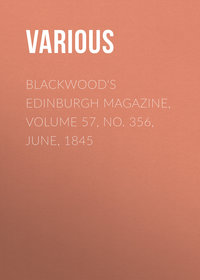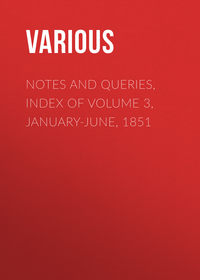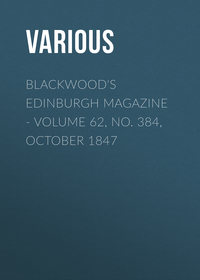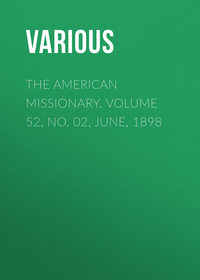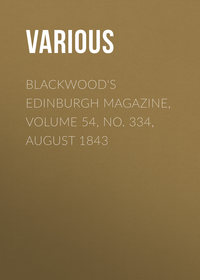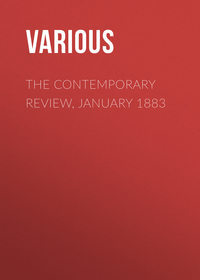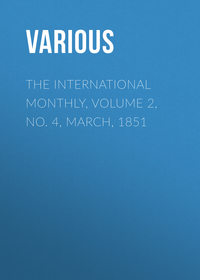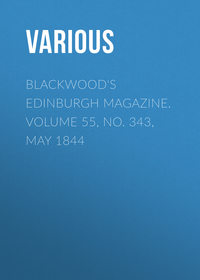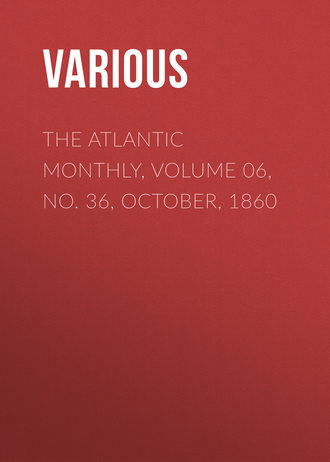 полная версия
полная версияThe Atlantic Monthly, Volume 06, No. 36, October, 1860
"But before he had divested himself of his tunic, his head rolled off and lay at his feet: his lips still murmured these words:
"'Go down there into that corn-field, and blow the horn, so that my friends may hear it.'
"'Into that corn-field I shall not go, neither shall I blow the horn. I do not follow the counsel of a murderer.'
"'Go, then, down under the gallows, and gather the balm which you shall find there, and spread it over my bloody throat.'"'Under the gallows I shall not go; on your bloody throat I shall spread no balm. I do not follow the counsel of a murderer.'
"She took up the head by the hair, and washed it at a clear fountain.
"She mounted her charger proudly, and, laughing and singing, she rode through the forest.
"When she reached the middle of the forest, she met the mother of Halewyn. 'Beautiful virgin, have you not seen my son?'
"'Your son, the Lord Halewyn, is gone hunting: you will never see him again.
"'Your son, the Lord Halewyn, is dead. I have his head in my apron, which is red with his blood.'
"And when she arrived at her father's gate, she blew the horn like a man. "And when her father saw her, he rejoiced at her return. "He celebrated it by a feast, and the head of Halewyn was placed on the table."Flemish writers claim as entirely their own that epic of the people, "Reynard the Fox." Their right to it was long contested; nor has anything been done since the labors of Willems, who, in opposition to the opinion of William Grimm, settles the authorship of the "Reinaert de Vos" on Utenhove, a priest of Aerdenburg. It seems natural to suppose that this most popular of Middle-Age productions should have originated in the very region which later gave to the world a school of painting that incarnated on canvas the phases of animal life, taking its delight and best inspirations in the burlesque side of human passions.
In its first period, Flemish literature found some encouragement from its princes. John I. of Brabant fostered it, and even took, himself, the title of Flemish Troubadour. Under Guy of Dampierre, who neither in heart nor mind was sympathetic with the people he ruled, we find Maerlant, still revered by his country; his name is ever coupled with the epithet of Father of Flemish Poets. Didactic rather than poetical, his influence was great in breaking down the barriers which separated the people from the higher classes, by adapting to their own home-idiom the best productions of the age. About this period we find prevalent those Northern singers corresponding to the Trouvères, Troubadours, and Jongleurs. They are in Flanders the Spreker, Segger, and Vinder, who, when travelling through the country, took the name of Gezel, received in town or village, court or hamlet, as the wandering minstrel of the South. The golden age when sovereigns doffed their royal robes to lay them on the shoulders of some sweet-singing poet, as the old chronicles tell us, was of short duration in the North, if ever the Sproken or erotic poems may be said to have brought their authors into such favor. On the other hand, we find some of the wanderers arrested for theft and other crimes.
Little light has been thrown on their first ante-historical attempts. Until the late labors of German philologers, little had been done to clear up the confusion resting on this period of literary history. As yet the field has scarcely been explored beyond the regions not immediately connected with the literature of Germany. We have long historical poems of little interest, arranged without order,—interminable productions of thousands and ten thousands of lines of uncertain date, didactic and encyclopedia-like, besides unmistakable remnants of a Netherlandish theatre.
The battle of Roosebeke, where the second Artevelde and his companions succumbed to superior numbers, was the last great enterprise of the Flemings against the French. Half a century earlier, a strong league had been formed against these powerful neighbors. In the interior, the country was divided into factions,—the partisans and enemies of France. Prominent were the Clauwaerts and the Leliarts, from the lion's claw and the fleur-de-lis which they respectively wore on their badges. The country, which has ever been one of the battle-fields of Europe, was abandoned to all the horrors of civil war. The Duke of Brabant was childless. The Count of Flanders gave his daughter, his only legitimate child, in marriage to the Duke of Burgundy; and the provinces soon came into the hands of those ambitious and restless enemies of the Court of France. It may easily be imagined that these events were not without their influence on a language deteriorated on the one hand by constant contact with a Romanic idiom, and in Holland by the transmission of the sovereign crown to the House of Avesnes.
The "Chambers of Rhetoric," an institution peculiar to the Low Countries, reached their highest point of prosperity under the Burgundian rule. The wandering life of poets and authors had nearly ceased. The Gezellen, settled in towns, and moved by the prevalent spirit which prompted men of one calling to unite into bodies, naturally fell into corporations analogous to the Guilds. Without attaching any very definite or clear idea to the term Rhetoric which they employed, these associations exerted great influence upon the whole literature of the Netherlands. Many would date their origin as far back as the early part of the twelfth century. In Alost, the Catherinists claimed to have existed as early as 1107, on the mere strength of their motto, AMOR VINCIT. At any rate, we are left entirely to conjecture with regard to the first beginnings of these literary guilds, which seem in many respects an imitation of the poetical societies of Provence. Every poet of note was a participant in them. In Flanders there was scarcely a town or village that did not possess its Chamber. Brabant, Holland, Zealand soon followed in the movement. One of the principal, the Fountain of Ghent, seems to have exercised a certain supremacy over the other confraternities of art.
The proceedings of these companies, protected at first by princes, were carried on with great magnificence. They were in constant communication with each other throughout the country. Their facteurs or poets composed songs and theatrical pieces, which were performed by the members. They had a long array of officers, with princely names; and none was complete without a jester. Their larger assemblies were accompanied with long festivities, the solemn entry into a town or village being styled Landjuweel (Landjewel). The nobility mingled in them, incited by the example of Henry IV. of Brabant or Philippe-le-Bel. The wealth of the Netherlands was displayed on these solemnities, and the citizens rivalled their monarchs in magnificence. The burghers of Ghent and Bruges and Antwerp shone, on these occasions, in the gaudy pomp of princely patricians. All were invited to take part and dispute the prizes awarded by fair hands.
It can scarcely be expected that these guilds, composed in many cases of mechanics, should give rise to works of the highest order of merit. Their dramatic representations were rather gorgeous than tasteful, their attempts at wit little better than buffoonery, their humor mere personal vituperation. Yet even in matters of taste they are not much inferior to the then more pretentious academies of other lands. It was an age of long religious dramas, of tortured rhymes and impossible metres, when strange and new versification imported from France found favor among a people whose silks and linens and rich tapestries were destined to reach a wider circulation than all the poetical effusions of their guilds, the "Lily," the "Violet," and the "Jesus with the Balsam Flower."
It was Philip the Fair who, wishing to centralize the scattered efforts of these societies, established at Malines, in 1493, a sovereign chamber, of which he appointed his chaplain, Pierre Aelters, sovereign prince. With an admixture of religion, in accordance with the spirit of the Middle Ages, the sacred number was fifteen. There were fifteen members. Fifteen young girls were to form part of it, in honor of the fifteen joys of Mary. Fifteen youths were instructed in the art of rhetoric, and the assemblies were held fifteen times a year. Charles V. was the last chief of this assembly, which had previously been removed to Ghent. In 1577 it greeted the arrival of the Prince of Orange, but this was its last sign of vitality.
The Chambers of Rhetoric reached their climax in a time of fermentation. The impatience, the feeling of uneasiness and restraint, is felt in the drama of these days, which was wholly under the control of the Chambers. The stage, that "mirror of the times," is often the first manifestation of the unquiet heaving and subsequent up-bubbling in the fluid compost of the mass that constitutes a nation. When freely developed, it is the pulse-beat of the people. And so, throughout the Netherlands, at the end of the fifteenth century and the beginning of the sixteenth, we find the allegorical drama giving way to more definite and direct personations. Those cold representations of vices and virtues, of vice in its nakedness, such as to render the reading, when not absolutely tedious, distasteful, to say the least, to our modern ideas,—all such aimless productions were giving way to the conscious expression of satire. Diatribes against prevalent abuses, personal invectives scarcely veiled, were fast becoming the order of the day. It is no wonder, then, that the guilds, which had found favor formerly, should gradually be crushed, in proportion as the rulers sought to check the spirit of reform. Among the authors of this period may be mentioned Everaert and Machet. The refrain was much cultivated, and not, like the drama, for the expression of dissatisfaction. Anna Byns, an oracle with the Catholic party, wrote when the language was in its most degenerate state, under Margaret of Austria. She was styled the Sappho of Brabant, though her poems are all religious. They were translated into Latin, and were read as masterpieces till the middle of the last century.
A taste for religious writing prevailed in the Netherlands throughout the sixteenth century. William van Zuylen van Nyevelt first published a collection of the Psalms of David. These, in imitation of the French Calvinists, were sung to the most popular melodies. Zuylen found many imitators. The Catholic party composed songs in opposition to the Reformers; and we have psalms and songs by Utenhove, the painters Luc de Heere and Van Mander, by Van Haecht and Fruytiers. A long list of obscure names, if we except those of Marnix and Houwaert, is mentioned as belonging to this period,—their works mostly didactic or controversial. Houwaert, a Catholic, one of the avowed friends and partisans of the Prince of Orange, courted the Muses in the hottest days of civil strife. He published a poem, in sixteen cantos, entitled "The Gardens of the Virgins," tending to show the dangers to which the fair sex is exposed, and condemning as unreal all love not centred in God. With a remarkable fertility of composition he possesses an uncommon smoothness of versification, combined with a power, so successful in his age, of illustration from history or romance, from the sacred writings or the legendary lore of the people. The work was received in those days of trouble with unbounded enthusiasm. Brabant was thought to have given birth to a new Homer. His praises resounded in verse and song, and the young girls of Brussels crowned him with laurel.
The government of the Duke of Alva, and the succeeding years of revolution, were a period of desolation for Flanders. The Guilds of Rhetoric were dispersed; town after town was depopulated; Ghent, the loved city of Charles V., lost six thousand families; Leyden, Amsterdam, Haerlem, Gouda, afforded refuge to the emigrants. The golden age of literary activity is about to dawn in the Dutch republic. In the other provinces the national language is more and more neglected. It gives umbrage to the foreign chiefs who act as sovereigns. With it they identify all the opposition that has prevailed against them. Archduke Albert carries his condescension no farther than to address in High-German such of his subjects as can speak only Flemish. His Walloons he treats with no more civility, answering them but in Spanish or Latin. Ymmeloot, lord of Steenbrugge, a native of Ypres, endeavors in 1614 to stem the current of opposition and reawaken a love for letters. He suggests many reforms in the versification, and gives the example. He is followed by many, and Ypres becomes for a time a centre of versifiers. But the spirit of originality has flown, and the literature of Holland is enriched with the name of many a Fleming who preferred exile to the new rule.
In 1618, the General Synod of Dordrecht decreed that a new translation of the Bible should be undertaken. Two Flemings, Baudaert and Walaeus, and two Dutchmen, Bogerman and Hommius, completed it. Like the work of Luther, this tended in a great measure to fix the language, preventing the preponderance of one dialect over the other.
Foreign imitation begins to prevail in Flanders. Frederic de Conincq constructs dramas on the models of Lope de Vega, with the necessary quota of nocturnal visits, abductions, dagger-thrusts, and bravado. An action entirely Spanish is conducted in the veriest patois of Antwerp. Ogier follows in his footsteps, introducing upon the stage the coarsest language. He represents vice in its most revolting forms. His theory, as he himself explains it, is, that "it is necessary to represent vice on the stage, as the Romans formerly on certain days intoxicated their slaves and showed them to their children, in order that they might at an early age become inspired with a disgust for debauchery." Yet his comedies enjoyed the highest favor, and have been pronounced by native critics among the most remarkable and meritorious productions of the epoch. They are ever distinguished by vivacity, truth, and fidelity, in depicting the many-sided life of the people. He seems to have been a literary Ostade or Teniers, with less of ingenuousness and good-nature in the portraiture.
In the mean time the French language continues to gain ground every day. In Brussels, native authors seek in vain to oppose the encroachments of the "Fransquillon," as Godin first styles them; but, save the feeble productions of Van der Borcht, the Jesuit Poirtiers, and the Dominican Vloers, we find but translations and imitations. Moons versifies some hundreds of fables. A half-sentimental, sickly style, consisting only of praises, of self-abnegation, of pious ejaculations, prevails. It is the worst of reactions;—the country, after its first outburst, had sunk into quietude, the lethargy of inaction.
Holland, on the other hand, is active and doing. Its poets and historians are at work, the precursors of Bilderdyk and Tollens, the poet of the people. Bruges, in the eighteenth century, produces two writers of merit,—Smidts and Labare. In French Flanders, De Swaen adapts from Corneille, and publishes original dramas. Many songs are composed both in the northern and southern provinces, mostly of a religious character. Philologers seek to revive the neglected idiom with little success. But the century is blank of great names. The Academy of Sciences and Belles-Lettres, established at Brussels by Maria Theresa, was composed of members totally unacquainted with the Flemish. It took no notice of the language beyond publishing a few prize-memoirs in its annals. The German barons who ruled cared little for their own tongue: how should they have manifested interest in that of their Belgian subjects? The subsequent French domination was no improvement. On the 13th of June, 1803, it was decreed by the Republic,—"In a year, reckoning from the publication of this present ordinance, the public acts, in the departments once called Belgium, … in those on the left bank of the Rhine, … where the custom of drawing up acts in the language of those countries may have been preserved, are henceforth to be written in French." The Bonaparte rule was not of a nature to restore former privileges. In spite of the feeble remonstrances that were urged against such arbitrary measures, an imperial decree of 1812 enjoined that all Flemish papers should appear with a French translation.
Under the rule of King William, vigorous measures were employed to reinstate the native idiom. At first warmly seconded, Government soon met with an unaccountable opposition even from its subjects. The Dutch was combated by those connected with education. It was ridiculed by the Walloon population. Since the independence of Belgium, the mouvement flamand has been felt more than once by the would-be French rulers. In 1841, a Congress was held in Ghent, where all the members of the Government spoke in Flemish; energetic protests were addressed to the Chamber of Representatives, all with little avail. At present, though the language is nominally on a par with French, it meets with little encouragement. The philological labors of Willems entitle him to a place among the greatest of the present century; he was until his death the leader of the intellectual movement of his country.
Of later authors, we may mention the laureate Ledeganck, Henri Conscience, whose works have now been translated into English, French, German, Danish, and Swedish, Renier Snieders, Van Duyse, Dantzenberg. Modern literature seems to have taken a new flight; it is animated by the purest love of country, by an ardent desire in its authors to revive the use of their native tongue. The tendency is rather Germanic. At the Singers' Festival, held in Ghent a short time ago, the songs sung breathed a spirit of union and love for the sister languages. As a fair sample, we may quote the following:—
"Welaen, Germaen en Belg tezaem ten stryd Voor vryheid, tael en vaderland! De vaen van't duïtsch en vlaemsche zangverbond Prael op't gentsch eeregoud! Wy willen vry zyn, als de adelaer Die stout op eigen wieken dryft, Voor wien er slechts een koestring is, de zon. Alom waer der Germanen tael Zich heft en bloeid en't volk, Daer is ons vaderland!"* * * * *The Glaciers of the Alps. Being a Narrative of Excursions and Ascents, an Account of the Origin and Phenomena of Glaciers, and an Exposition of the Physical Principles to which they are related. By JOHN TYNDALL, F.R.S., etc., etc. With Illustrations. London: John Murray. 1860. pp. xx., 444.
Our readers are probably aware that the question of the causes of glacier formation and motion, cool as the subject may seem in itself, has demonstrated the existence of a great deal of latent heat among scientific men. In England, the so-called viscous theory of Professor J.D. Forbes held for a long while undisputed possession of the field. According to him, "a glacier is an imperfect fluid, or viscous body, which is urged down slopes of a certain inclination by the mutual pressure of its parts." With that impartial superciliousness to all foreign achievement which not seldom characterizes the British mind, the credit of all the results of observation and experiment on the glaciers was attributed to Professor Forbes, who seems to have accepted it with delightful complacency. But presently doubt, then unbelief, and at last downright opposition began to show themselves. The leader of the revolt was Professor Tyndall, whose book is now before us. The controversy has begotten no little bitterness of feeling; but none is shown in Mr. Tyndall's volume, which is throughout written in the truest spirit of science,—with the earnest frankness that becomes a seeker of truth, and the dignity that befits a lover of it.
Not content with any theoretic antagonism to the Forbes explanation of the phenomena, Mr. Tyndall devoted all the leisure of several years to an examination of them on the spot. At the risk of his life, he verified the previous observations of others and made new ones himself. At home, he made experiments upon the nature of ice, especially upon its capacity for regulation and the effect of pressure upon it. He satisfied himself that snow may be changed to ice by pressure, that crumbled ice may in like manner be restored to its original condition, and that solid ice may be forced to take any form desired. Under proper conditions, lamination may be produced by the same means. The result of his investigations is, that the glacier is a solid body, and that pressure answers all the requirements of the glacier-problem, and is the only thing that will.
The book is one of uncommon interest, and discusses many topics beside the glaciers, though nothing that is not in some way related to them. Mr. Tyndall does justice to former investigators,—especially to M. Rendu, who, though imperfectly supplied with demonstrated facts, theorized the phenomena with the happiest inspiration,—and to Agassiz, of whose important observations, establishing for the first time the fact of more rapid motion in the middle of the glacier, Professor Forbes had appropriated the credit. The style is remarkably agreeable, in description vivid, and in its scientific parts clear. Indeed, we do not know whether we have enjoyed the narrative or the science the most. Professor Tyndall has the uncommon gift of being able to write science so that the unscientific can understand it, without descending to the low level of science made easy. The Royal Institution may well congratulate itself on having in him a man every way qualified to succeed Faraday, whenever (and may it be long first!) his chair is vacant.
* * * * *ART
MR. JARVES'S COLLECTIONIt seems an odd turn in the kaleidoscope of Fortune that associates a Prime Minister of the Sandwich Islands—where the only pictorial Art is a kind of illumination laboriously executed by the natives on each other's skins, thus forming a free peripatetic gallery—with a collection of pictures by early Italian masters. It is certainly a striking illustration of American multifariousness. From the dawning civilization of Hawaii Mr. Jarves withdraws to Italy, where culture has passed far beyond its noon, and finds himself equally at home in both. From Italy he has returned to America with by far the most important contribution to historical Art that has ever reached us. It is not easy to overestimate its value, whether intrinsically, or as an aid to intelligent and refining study. We can hardly expect, it is true, ever to form such collections of Art in this country as would save our students the necessity of visiting Europe. This, indeed, would be hardly desirable; since a great deal of the refining and enlightening influence of foreign travel and observation is not received directly from the special objects that may have drawn us abroad, but incidentally and unexpectedly, by being brought into contact with strange systems of government and new forms of thought. But what we might have is such a collection as would enable those of us who cannot travel to enjoy some of the highest aesthetic advantages of travel, and would send our students to the galleries of the Old World already in a condition to appreciate and profit by them. Mr. Jarves's pictures afford the opportunity for an excellent beginning in such an undertaking.
Mr. Jarves's object has been to form a gallery that should exhibit the origin, progress, and culmination of Italian Art from the thirteenth to the seventeenth century, in such chronological order as should show the sequence and affiliation of the various schools and the various motive and inspiration that were operative in them. To quote his own language, Mr. Jarves began his undertaking with no "expectation of acquiring masterpieces, or many, if any, of those specimens upon which the reputation of the great masters is based. These are in the main either fixtures in their native localities or permanently absorbed into the great galleries of Europe; and America may scarcely hope ever to possess such. He did propose, however, to get together a collection which should fairly represent the varied qualities of the masters themselves, and the phases of inspiration, religious, aesthetic, or naturalistic, by which they were actuated. And he claims now to have succeeded in this to an extent which in the outset he did not dare to hope, and to have secured for the collection the approving verdict of European taste and connoisseurship in the recognition of it as a valuable historical gallery of original paintings of the epochs and schools they claim to represent.


